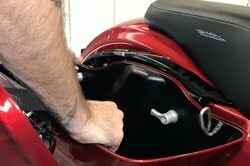Riding Impression of the 1999 Harley-Davidson FXSTS Springer Softail
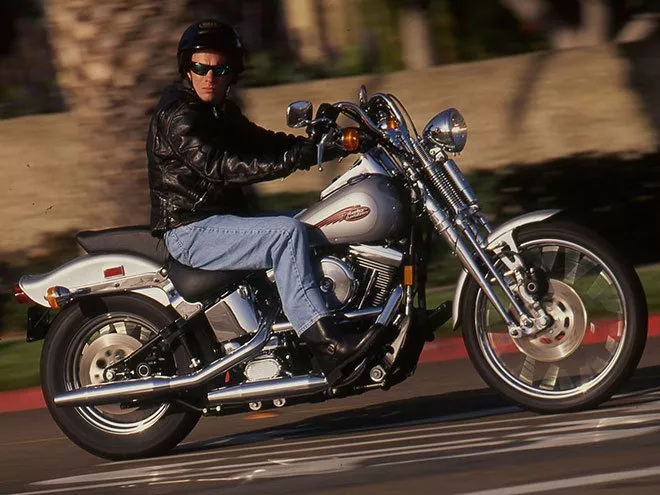
The 1999 Springer Softail embodies the idea that something could both look good and work well.
Brian Blades
This article was originally published in the 1999 August-September issue of Cycle World’s Big Twin.
No one minds style. If something works, and looks good doing it, all the better.
Obviously, this is a familiar concept to the Milwaukee faithful, who appreciate the lasting beauty in the appearance of their machines. And this is also what makes the Springer Softail such a pleasant surprise. Its suspension, at both ends, was conceived primarily to serve the needs of styling, not function. The unique rear setup is designed to mimic the look of the classic hardtails, while the exposed workings of the front suspension hark back to the bikes of the Thirties and Forties.
But beyond just looking good, it actually works. And you can thank a little computer horsepower for that.
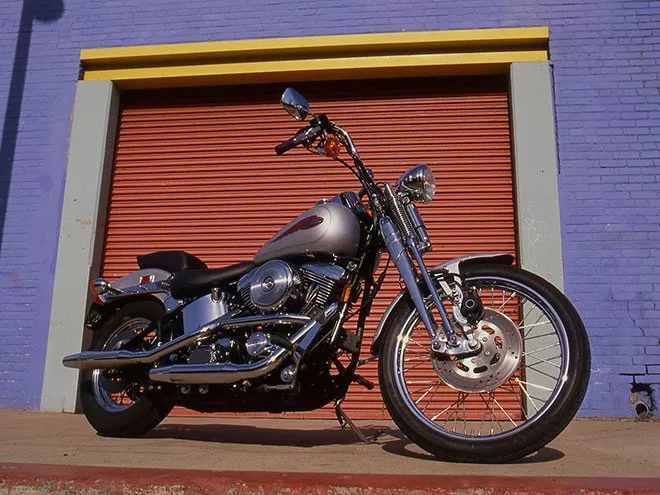
A classic view of a classic shape: tall, thin front wheel on a chromed, exposed-workings fork, tapering back to a short, fat rear wheel via a teardrop tank and a deeply stepped seat.
Brian Blades
When the Springer Softail first appeared a decade ago, Harley let it be known that a huge amount of CAD (computer-aided design) time, as well as extensive on-the-road development, had been spent bringing the dated front-suspension concept up to modern performance standards. So, while the latter-day Springer fork is certainly one of the more ornate pieces in Harley’s bag of classic-bike styling tricks, don’t let that blind you to the fact that it’s also a quite competent suspension medium.
Save for paint and graphics, the ’99 FXSTS is the same bike it was in 1998, including the powerplant. The Springer retains Evo propulsion for ’99, since the Softails have not yet been endowed with the new Twin Cam 88 motor. That will no doubt be dealt with for the 2000 model year, as Harley has revealed plans for a major press announcement in July. Meantime, the Springer and its Softail brethren carry on with the most popular motorcycle powerplant on the planet.
But that’s not such a bad thing. In stock form, the Evo might not match the new Twin Cammer for all-out performance, but it’s as reliable as a redbrick (if you don’t think that’s important, just ask Twin Cam owners who have suffered the much-discussed cam-bolt problem), and the aftermarket offers enough hop-up equipment for this generation of Big Twin to let you create just about any kind of power curve you desire.
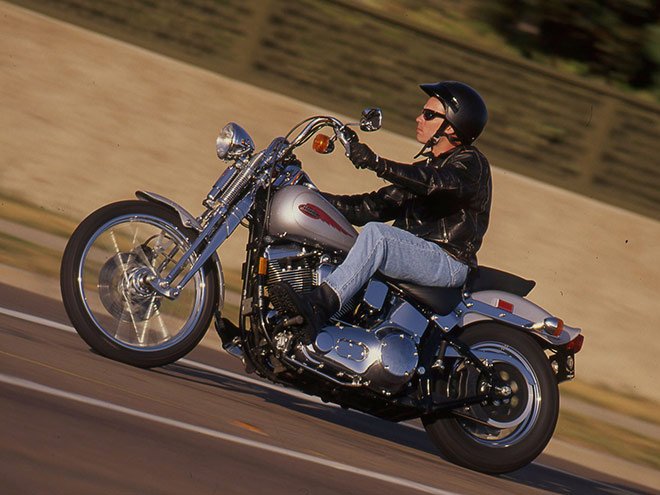
On city streets, few front suspensions are happier than the Springer’s.
Brian Blades
Still, there’s no denying that the Springer is a bit anemic, in both sound and performance, compared to Evo models of just a few years ago. Ever-tightening noise and emissions regulations have taken their toll on this 1980s-era engine design. And the taller overall gearing imposed on all Softails also contributes to the Springer’s lackluster acceleration. The low-end lunge still is decent, delivering more than enough thrust to humiliate traffic away from lights, and it provides the kind of lugging low-end that makes shifting optional as you move through surface streets. It’s just that the top-end power is meager, but about what you would expect from any engine that has had its intake and exhaust systems effectively strangled.
Otherwise, aside from a bit of cold-bloodedness on cool mornings, mostly the result of lean jetting in the 40mm Keihin carb, our test Springer ran flawlessly. Similarly, the shifting action of the five-speed tranny was smooth, solid and glitch-free.
When you climb aboard the Springer, the first thing you notice, obviously, is the seat. It’s low, at just over 26 inches, and a lot wider than it appears in profile. Most important, it proves to be comfortable for any ride within the 4.2-gallon tank’s range.
From the seat, it’s hard to miss the gleaming chrome windings of the Springer fork, which are brightly mirrored on the back of the small, low-profile headlight nacelle. The front end reminds you of a large power transformer until you start to roll, at which time the up-and-down pulsing of the spring pack as the FXSTS encounters pavement irregularities is more reminiscent of the Evo’s pushrod valve train.

Despite its styling-for-styling’s-sake appearance, the Springer Softail actually is a surprisingly versatile and functional ride.
Brian Blades
But while the front end is cool to watch when on the move, you’ll be thrilled to discover how well it works. Most of us know that the late-night/wet-streets/steam-from-manhole-cover image is much more marketing hype than when/where most of us actually ride, but on city streets, few front suspensions are happier than the Springer’s. Fork action is surprisingly plush, and, combined with the wire-spoke, 21-inch front wheel, swallows even big potholes fairly easily. At parking-lot speeds, the front end can feel a little floppy, and you sense the bike wanting to turn inward more than on most other H-D models, but this sensation disappears just above walking speeds.
Out on the open road, the Springer works best at a relaxed pace. The buckhorn handlebar is one of the cues that give the bike its chopper-esque identity and are nicely placed for threading through traffic. For higher-speed work or extended freeway hauls, the pullbacks are too high and too close to the rider, however, and their narrow profile doesn’t provide quite as much leverage as you get on the flatter-barred Sport models. All of this adds up to a seating position that is better-suited to low-speed work than it is to faster running at highway speeds.
Those ergonomics aside, the Springer eats up the open road rather easily and comfortably, especially if kept below 70 mph or so. Above that speed, vibration from the solid-mount motor can get to you after a while; but below it, the Springer lopes along smoothly and effortlessly.
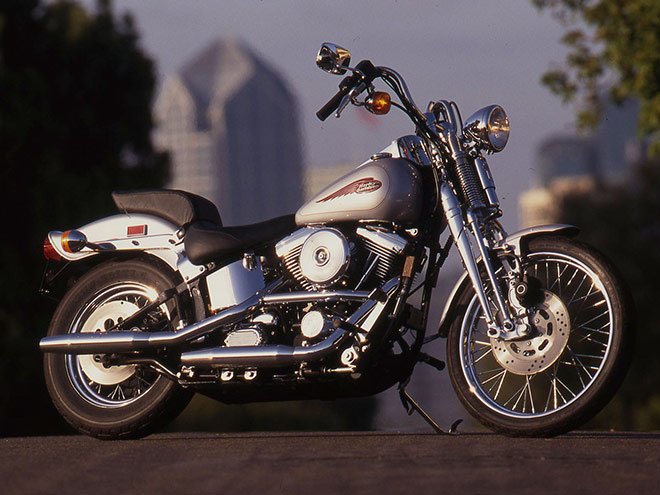
Beyond just looking good, it actually works. And you can thank a little computer horsepower for that.
Brian Blades
If the road gets a bit curvy, there’s no need to dig out the map in search of an alternative route. Despite its styling-driven suspension systems, long wheelbase and skinny, 21-inch front tire, the Springer arcs through corners with surprising ease and aplomb. You have to reach fairly aggressive lean angles before the bike starts protesting. And with the engine’s ample torque, most twisty roads can be handled in just one or two gears.
When the time comes to stop, the front and rear 11.5-inch single discs do a good job of hauling the 625-pound Springer down from speed. And no matter how much we abused the brakes, they never exhibited the slightest bit of fade.
What we have here, then, is a bike that, despite being a virtual icon of classic American styling, performs up to modern standards. At $15,010 in basic black (add $240 for the Diamond Ice Pearl paint on our test bike), the Springer certainly is not one of the less-expensive Big Twins, but you get value for your money. The front suspension alone qualifies as rolling artwork, matched by the clever rear suspension that has made Softails the most popular line of Harley models for quite a few years.
Proving once again that style and function need not be mutually exclusive. Not where the Springer Softail is concerned, at least.


